Overview
- Description
- The Frank Meissner papers contain material related to Frank Meissner, a student and member of a Zionist youth group who fled Czechoslovakia (Czech Republic) and attended school in Denmark, Sweden, and England during World War II. The majority of the papers are correspondence from Frank’s parents, living in his hometown of Třešť, and later Theresienstadt concentration camp. In addition, the collection includes school, financial, and identification documents. The photographs in the collection are of Frank and his family, the town of Třešť, and various moments during his time as a student in England and Denmark. Also included are two diaries and an autograph book.
The majority of the Frank Meissner papers contain correspondence from Frank’s parents while he was away in Prague, and later at school in Denmark and Sweden. Both Charlotte and Norbert shared space on the letters, and often brother Leo would be included as well. The correspondence were written from Frank’s hometown of Třešt̕, and later Theresienstadt concentration camp, where his parents were imprisoned. Correspondence from after the war are mainly from friends. Other material in the collection are documents obtained by Frank throughout his time away at school. His school documents include report cards, certificates of adulthood, and various other papers from the Agricultural College of Sweden and the Veterinary and Agricultural College at the University of Copenhagen. The financial documents contains bank books and other concerns for Frank involving transferring currency to Sweden and a letter concerning his father’s estate after the war. The identification documents include a proof of residency and testimony to Frank’s attendance at school. Also included in the collection are photographs of Frank’s family and hometown, two personal diaries, an autograph book, and items Frank collected later in life such as photocopies of an article concerning the history of the Jews in Trest and a German picture book displaying images of various concentration camps. - Date
-
inclusive:
1938-1995
- Credit Line
- United States Holocaust Memorial Museum Collection, Gift of Margit Meissner
- Collection Creator
- Frank Meissner
- Biography
-
Franz (Frank) Meissner was born on September 18, 1923, in Trest, Czechoslovakia to Norbert and Lotte. He had an older brother, Leo, and his paternal grandfather also lived with them. His father had owned a wooden shoe factory, but it closed during the economic crisis of 1929. His mother worked as a secretary at her brother’s machine factory to support the family. His father was the president of their synagogue and they went to synagogue every morning. The Jewish community in Trest was small, with only 64 members in 1930. There was no secondary school in Trest, so when Frank was 11 years old he attended school in a neighboring town. In 1937, he left school to apprentice at his uncle’s machine factory. That year he also joined Youth Aliyah, a Zionist youth group, and traveled to Prague to learn Hebrew and to develop a farm proposal for emigration to Palestine. Both brothers wished to emigrate from Czechoslovakia, with the entire family joining them later.
In October 1939, because of increasing persecution by the Germans, Youth Aliyah arranged the emigration from Czechoslovakia to Denmark of many members, including 16 year old Frank. Leo, still waiting to go to Palestine, chose to remain with their parents. Frank was strip searched at the border wehn he eft October 24. He and the other boys were sent to live and work on farms in Denmark. After an initial unpleasant placement, Frank stayed with the Nielsen family, where he was made to feel like part of the family and became involved with the Nielsen’s church. In 1941, he earned a scholarship to attend an agricultural high school in Denmark. Through these early years of the war, Frank received weekly letters from his family. In May of 1942, his family wrote that they were getting ready for their departure, although they do not know where they are going. They tell Frank that they are proud of him and that he should not worry about the family.
After graduating high school, Frank enrolled in the Agricultural College of the University of Copenhagen. In October 1943, he received a call from his landlady telling him not to return home because the Gestapo was looking for him. With the aid of a friend with connections to the underground resistance movement, Frank was smuggled on a fishing boat to Sweden, where he finished his education. While mail service to Europe temporarily improved, and Frank could occasionally send packages of food, he no longer received any letters in return. In September 1944, Frank went to England and was told that if he wanted refuge and a Czech passport, he had to volunteer for the Czech government in exile army. He served in the Royal Air Force in Scotland for the rest of the war. He intensified his efforts to find his family and learned that they had been deported to Theresienstadt. Around May or June 1945, Frank went back to Prague to search for them. A woman from their town wrote Frank that his family had not returned after the war and that after a year in Theresienstadt they had been sent to Auschwitz where they perished. In 1946, he was demobilized and returned to the University in Copenhagen, graduating in 1948 with a bachelor of science in agronomy. He returned to Czechoslovakia, but left six months after the Communist coup that February. He emigrated to the United States in January 1949. He attended Iowa State College and after receiving a masters in agronomy, transferred to the University of California, and 3 years later to Cornell where he earned his doctorate. In 1953, Frank married Margit Morawetz, originally from Austria. She had fled from Prague to France, eventually emigrating to the US in April 1941. 1953. Frank, age 67, died from cancer January 19, 1990, in Maryland.
Physical Details
- Genre/Form
- Identification cards. Correspondence. Photographs. Photographic postcards. Diaries. Autograph books. Documents.
- Extent
-
1 box
1 oversize box
- System of Arrangement
- The Frank Meissner papers are arranged as a single series.
Rights & Restrictions
- Conditions on Access
- There are no known restrictions on access to this material.
- Conditions on Use
- Material(s) in this collection may be protected by copyright and/or related rights. You do not require further permission from the Museum to use this material. The user is solely responsible for making a determination as to if and how the material may be used.
Keywords & Subjects
- Topical Term
- World War, 1939-1945--Refugees--Denmark. World War, 1939-1945--Refugees--Great Britain. World War, 1939-1945--Refugees--Sweden. Refugees, Jewish--Denmark. Refugees, Jewish--Great Britain. Jewish Refugees--Sweden. Jews--Czech Republic--Třešt̕--History--20th century.
- Geographic Name
- Třešt̕ (Czech Republic) Prague (Czech Republic) Copenhagen (Denmark)
Administrative Notes
- Holder of Originals
-
United States Holocaust Memorial Museum
- Legal Status
- Permanent Collection
- Provenance
- The papers were donated to the United States Holocaust Memorial Museum in 2005 by Margit Meissner, the wife of Frank Meissner.
- Funding Note
- The accessibility of this collection was made possible by the generous donors to our crowdfunded Save Their Stories campaign.
- Special Collection
-
Save Their Stories
- Primary Number
- 2004.692.1
- Record last modified:
- 2024-04-11 13:18:56
- This page:
- https://collections.ushmm.org/search/catalog/irn522614
Additional Resources
Download & Licensing
In-Person Research
- Available for Research
- Plan a Research Visit
-
Request in Shapell Center Reading Room
Bowie, MD
Contact Us
Also in Frank Meissner collection
The collection consists of pins and medals, documents, correspondence, photographs, and a publication relating to the experiences of Frank Meissner before the Holocaust in Trest, Czechoslovakia, during the Holocaust when he emigrated to Scandinavia, and during and after the war in Great Britain when he served n the Czech Air Force for the Czech government in exile.
Date: 1939-1946
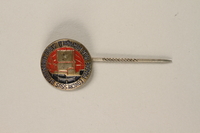
Enameled stickpin for the Studiosorum World Congress owned by a former Czech Jewish soldier
Object
Red and blue enameled stickpin acquired by Frank Meissner during the 1946 Studiosorum Congress in Prague. It features the logo design of a globe, open book, and flaming torch that symbolize youth's persisent quest for knowledge. This was the founding congress of the International Student Union created to promote democracy and education among students of all nations. At the age of 16, Frank left Trest, Czechoslovakia, in 1939 to avoid the increasingly harsh Nazi persecutions of Jews. He went to Denmark with Youth Aliyah to attend agricultural school. In fall 1943, when the Germans decided to deport all Jews from Denmark, Frank was smuggled on a fishing boat to Sweden. During his exile, he received weekly letters from his family, even after their deportation to Theresienstadt ghetto. The letters stopped in 1943. In the fall of 1944, Frank learned that his family had been sent to Auschwitz concentration camp. He joined the Czech army-in-exile in Great Britain. After the war ended in May 1945, Frank returned to Czechoslovakia searching for his family, but he found no survivors.
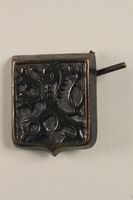
Czech lion coat of arms cap badge owned by a Jewish veteran of the Czech Air Force in exile
Object
Tinnie, or pressed tin pincap badge owned by Frank Meissner, who served in the Czech Air Force from 1944-1945 for the Czech government in exile. It features the Czech coat-of-arms with the rampant split-tailed lion of Bohemia. At the age of 16, Frank left Trest, Czechoslovakia, in 1939 to avoid the increasingly harsh Nazi persecutions of Jews. He went to Denmark with Youth Aliyah to attend agricultural school. In fall 1943, when the Germans decided to deport all Jews from Denmark, Frank was smuggled on a fishing boat to Sweden. During his exile, he received weekly letters from his family, even after their deportation to Theresienstadt ghetto. The letters stopped in 1943. In the fall of 1944, Frank learned that his family had been sent to Auschwitz concentration camp. He joined the Czech army-in-exile in Great Britain. After the war ended in May 1945, Frank returned to Czechoslovakia searching for his family, but he found no survivors.
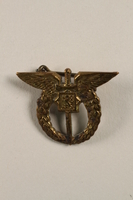
Czech Air Force pilot badge issued to a Jewish veteran
Object
Czech Air Force pilot badge issued to Frank Meissner for his service in the Czech Air Force from 1944-1945 for the Czech government in exile in Great Britain. It may be an observers badge. At the age of 16, Frank left Trest, Czechoslovakia, in 1939 to avoid the increasingly harsh Nazi persecutions of Jews. He went to Denmark with Youth Aliyah to attend agricultural school. In fall 1943, when the Germans decided to deport all Jews from Denmark, Frank was smuggled on a fishing boat to Sweden. During his exile, he received weekly letters from his family, even after their deportation to Theresienstadt ghetto. The letters stopped in 1943. In the fall of 1944, Frank learned that his family had been sent to Auschwitz concentration camp. He joined the Czech army-in-exile in Great Britain. After the war ended in May 1945, Frank returned to Czechoslovakia searching for his family, but he found no survivors.
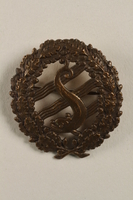
Wreath shaped badge owned by a Jewish veteran of the Air Force for the Czech government in exile
Object
Wreath shaped pin with a fish owned by Frank Meissner who served in the Czech Air Force from 1944-1945 for the Czech government in exile. At the age of 16, Frank left Trest, Czechoslovakia, in 1939 to avoid the increasingly harsh Nazi persecutions of Jews. He went to Denmark with Youth Aliyah to attend agricultural school. In fall 1943, when the Germans decided to deport all Jews from Denmark, Frank was smuggled on a fishing boat to Sweden. During his exile, he received weekly letters from his family, even after their deportation to Theresienstadt ghetto. The letters stopped in 1943. In the fall of 1944, Frank learned that his family had been sent to Auschwitz concentration camp. He joined the Czech army-in-exile in Great Britain. After the war ended in May 1945, Frank returned to Czechoslovakia searching for his family, but he found no survivors.
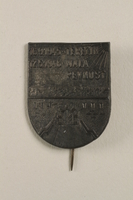
1st Anniversary commemorative pin for the victims of Theresienstadt acquired by a Czech Jewish survivor
Object
First anniversary commemorative pin for the May 12, 1945, liberation of Theresienstadt concentration camp acquired by Frank Meissner, whose family had been imprisoned in the ghetto/labor camp in Czechoslovakia. On September 16, 1945, there was a public ceremonial burial for 601 victims exhumed from six mass grave sites uncovered at the Small Fortress. From 1940-1945, the Small Fortress served as the prison at the Terezin camp. At the age of 16, Frank left Trest, Czechoslovakia, in 1939 to avoid the increasingly harsh Nazi persecutions of Jews. He went to Denmark with Youth Aliyah to attend agricultural school. In fall 1943, when the Germans decided to deport all Jews from Denmark, Frank was smuggled on a fishing boat to Sweden. During his exile, he received weekly letters from his family, even after their deportation to Theresienstadt ghetto. The letters stopped in 1943. In the fall of 1944, Frank learned that his family had been sent to Auschwitz concentration camp. He joined the Czech army-in-exile in Great Britain. After the war ended in May 1945, Frank returned to Czechoslovakia searching for his family, but he found no survivors.



